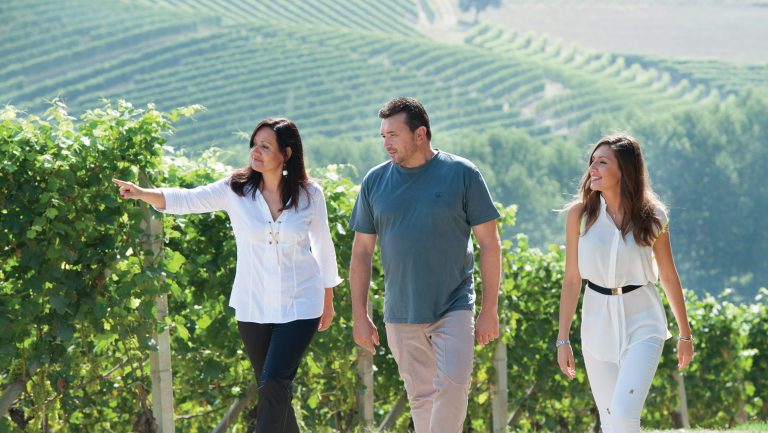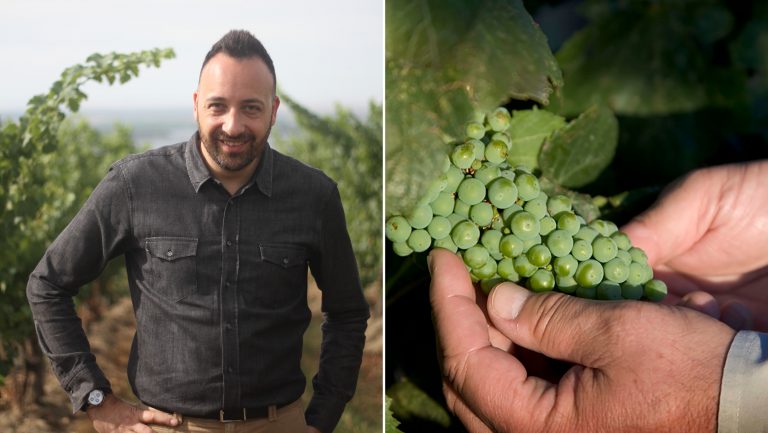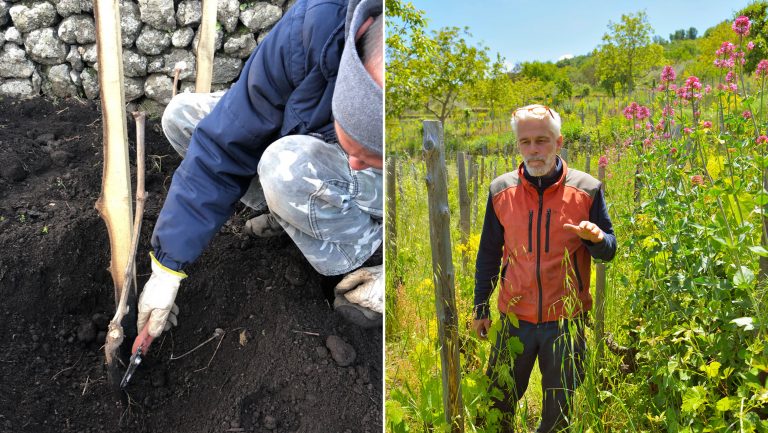The commune of La Morra rises above everything else in the Barolo region of northwest Italy. The town’s piazza opens on one side to a magnificent vista, where you can absorb one of Europe’s most breathtaking viticultural sights: a sprawling tapestry of Nebbiolo, Barbera, and Dolcetto vineyards carpeting the hills as far as the eye can see.
What is not visible, for obvious reasons, are the roots—and many of them are American in origin. As occurred throughout much of Europe, the phylloxera outbreak of the late 19th and early 20th centuries wiped out most of Barolo’s vineyards. The only feasible solution for restoring them was to graft vines onto American rootstock, which is naturally resistant to the root-eating insect.
Yet pockets of ungrafted vines (often referred to as own-rooted vines) still exist in Europe, usually because of a convergence of terroir and luck.

Don’t miss the latest drinks industry news and insights. Sign up for our award-winning newsletters and get insider intel, resources, and trends delivered to your inbox every week.
In Valle d’Aosta, the vineyards of Blanc de Morgex et de La Salle dodged phylloxera because of their extreme elevation. On Santorini in Greece—and other volcanic terroirs—the ashen soil has been enough to keep the pest at bay. Even in La Morra, a handful of own-rooted vineyards still exist. The notable Barolo producer Elvio Cogno tends a small vineyard of centenarian Barbera vines that thrive on an ancient root structure that has somehow survived.
“It is definitely an unusual Barbera,” says Valter Fissore, the winemaker and co-owner of the Elvio Cogno estate. He adds with a bit of pride that this Barbera is tricky to identify in a blind tasting because of its distinctive sweet spice and a strong graphite note on the back palate. “But it’s difficult to know which one of the vineyard’s characteristics [high altitude, cold climate, sandy soil, or rootstock] is responsible for this unique taste,” he says. “It’s probably the combination of all of them.”

But make no mistake, the mystique of the roots matters from a marketing perspective. Elvio Cogno’s wine is even labeled Pre-Phylloxera Barbera d’Alba, as if to underscore the vineyard’s survivor cred. Among winemakers, collectors, sommeliers, and even botanists, the debate on own-rooted vines usually results in more questions than answers, but typically the discussion begins and ends with taste. Do own-rooted vines yield better fruit?
A Matter of Control
“In science, you have to control for issues to be able to understand if anything has an impact,” says Gregory Jones, Ph.D., the director of wine education and the wine studies coordinator at the Evenstad Center for Wine Education at Linfield College in McMinnville, Oregon. Jones says that to isolate the impact of the roots on wine, all other variables have to be held constant—from irrigation to sun exposure to soil chemistry and even pruning methods. Yet, few such examples exist.
Still, Jones believes that there is logic to the notion that own-rooted vines offer something special. “Graft unions are never perfect,” he says, observing that when two pieces of the plant material—the scion and the rootstock—are put together, the connectivity will naturally be misaligned in places. Own-rooted vines have no such issue, which leads to a clearer pathway for nutrients from the soil to travel to the leaves and fruit clusters.
“Own-rooted vines have a tendency to [promote] growth quicker and reach a mature level quicker,” Jones says, adding that the union point between trunk and root in a grafted vine can also be an area of “potential failures,” ranging from susceptibility to hard freezes to tissue connectivity problems. “All things being equal,” says Jones, “if I had a vineyard, I would love to have all own-rooted vines. But if I had anything I needed to protect against, I would go to grafted vines immediately.”

For Juan Muñoz-Oca, the vice president of winemaking at Ste. Michelle Wine Estates in Woodinville, Washington, the difference between own-rooted vines and vines grafted to rootstock is the difference between 20/20 vision and wearing glasses. “You’re seeing the same thing,” he says, “but it’s just slightly distorted with glasses.”
Much of this discrepancy Muñoz-Oca attributes to an ungrafted vine’s complete connection from the root system to the canopy. Almost all of Washington’s vineyards are own-rooted, a reflection of the state’s hostile environment for phylloxera and many other root pests. The winters are harsh, the soil has poor water retention, and the climate is arid: a trifecta of doom for phylloxera’s survival.
At Ste. Michelle Estates, Muñoz-Oca has experimented with plots of Cabernet Sauvignon to better understand the advantages and disadvantages of certain root selections, including own-rooted vines. While he doesn’t have definitive proof that the root structure accounts for the ultimate taste of wine in the glass, he firmly believes that own-rooted vines carry a distinct advantage.
“I cannot quantify the difference,” he says. “But I can totally tell you that vines that are on their own roots have a typicity to them—and this goes for all varieties, red and white. [Wines from] own-rooted vines are very, very expressive. When you put [a grafted vine] on a rootstock, it’s as if you are filtering a little bit of what the wine might get from the terroir.”
Finding the Perfect Combination
Acclaimed Etna Rosso producer Frank Cornelissen can actually quantify the difference between own-rooted vines and grafted vines in his various vineyard plots of Nerello Mascalese—those from own-rooted vines consistently have more acidity.

Cornelissen can’t fully explain why, but grapes from his ungrafted vines have a 0.1 pH value below that of grapes from grafted vines, even when he harvests them at the same stage of phenolic ripeness. While some of this may have to do with the unique terroir of Etna, he sees it as a distinct advantage resulting from using own-rooted vines. “Especially now,” he says, “with climate change all over the globe, where everything is getting warmer and the wines are getting a bit bigger.” To create a wine with elegance—at least on volcanic soil with Nerello Mascalese, as Cornelissen does—own-rooted vines have consistently provided a more compelling outcome.
Still, only four of Cornelissen’s 24 total hectares of vines are own-rooted, a fact he attributes to government intervention decades before he started producing wine. “When phylloxera came, the government subsidized the replanting; the people making wine couldn’t have cared less whether it was grafted or ungrafted—40, 50 years ago, people were just surviving. We can talk about this [own-rooted vines] because we live in an age of luxury in the world of wine.”
In Cornelissen’s opinion, though, vine age and selecting the right clone for the specific soil have a larger bearing on the outcome of the wine. But, he says, “if you can combine [the right DNA and soil with own-rooted vinestock], you really hit the bull’s-eye.”
Preparing for the Future
One of the major threats facing winemakers today is scarcity of water. As certain regions grow warmer and more arid, says Jones, the soil is becoming more saline. With increased salt concentration around vine roots, winemakers who’ve been using own-rooted vines may need to look to drought-resistant rootstock when the time comes to replant.
A winemaker who is living this exact scenario is Sven Bruchfeld of Polkura in the Colchagua Valley of Chile. Nationwide, Chile has never had a problem with phylloxera, so many of its vineyards are own-rooted. “There is no ‘You have to graft’ in Chile,” Bruchfeld says. “You do it if you want, or under certain circumstances if it offers advantages.”
Bruchfeld is investigating grafted-rootstock options to guard against the recurring problem he has with drought. “Central Chile is like California,” he explains. “No rain or very little in the summer.” While he has emphasized dry-farming techniques as much as possible during his time at Polkura, he sees the climate trending in a drier, more arid direction, and he is not confident in the ability of his own-rooted vines to guard against drought. “Today, with new plantings and since we have less and less water, we are using these rootstocks everywhere, even with irrigation. I need rootstocks so I can use less water.”
The problem of water is compounded by another reality. Chile is rife with nematodes—parasitic roundworms that present a whole different threat to roots. While nematodes aren’t present now in Polkura’s vineyards, the risk will increase in a few years when Bruchfeld expects it will be necessary to change his irrigation source. Says Bruchfeld, “We need to be prepared.”

But he also adds that Chile’s history of own-rooted vines should be a point of pride for the nation, adding that the popularity of País as a variety may open doors to interesting new graft combinations. “País has awesome roots,” he says, “so why not graft my Syrah on País? Technically, that is Vitis vinifera on Vitis vinifera.”
Protecting Vinous Heritage
One of the world’s best-known wines from own-rooted vines is a bit of a fluke. Champagne Bollinger’s Vieilles Vignes Françaises Champagne draws its unique Blanc de Noirs character from two walled vineyards—Clos des Chaudes Terres and Clos Saint-Jacques—in Ay, France, that have somehow dodged the phylloxera bullet for more than 100 years.
“Vieilles Vignes Françaises is very characteristic of traditional Champagne,” says Denis Bunner, the deputy chef de cave at Bollinger. The vintage wine, which is only released in exceptional years, draws its intense power and concentration from a small set of high-density, own-rooted vines that are pruned in the traditional en foule technique, which was used across Champagne before the phylloxera outbreak. Essentially, when the vines are cut back each year, the second-year growth is buried underground, adding layers to the root structure, which Bunner says “refreshes the [root]stock.”
“It is very interesting to taste once in your life,” he says, with a laugh, “because the wine is so present that you forget the bubbles.”
What exactly makes the wine’s profile so unique is likely a combination of factors, but according to Bunner, the ungrafted vines are the main contributor: “That is the magic of Vieilles Vignes Françaises—because all the [other] Champagne has been grafted.” Bunner adds that the ungrafted Pinot Noir vines provide a varietal intensity he has not found elsewhere.
How these two Bollinger vineyards have endured is also a mystery, but they may be on borrowed time. Through the 1990s, Vieilles Vignes Françaises included grapes from a third pre-phylloxera vineyard, but eventually phylloxera found it and devoured the ancient root system. Bollinger’s attempts to replant the vineyard on own-rootstock were unsuccessful, and a similar fate could await the en foule vines of Clos des Chaudes Terres and Clos Saint-Jacques.
A Better Wine or a Better Story?
The power of own-rooted vines may be tangible to those who get their fingernails dirty in the vineyard, but to an ordinary consumer perusing a wine list, does it matter?
“It matters to the wine buyer because it matters to the winemaker,” concludes Ste. Michelle’s Muñoz-Oca. “Wine buyers tend to lean on winemakers that lean on their craft and knowledge to make wines with a clear point of view.” He adds that the discussion about own-rooted vines is not unlike the debate over biodynamic techniques and their impact on a wine’s taste. Scientific evidence that suggests a link between certain practices and an increased sensory profile may be scant or tenuous at best, but if a particular practice heightens the winemaker’s care of the vineyard, ultimately a better wine is made.
Master Sommelier Brahm Callahan—the beverage director of Himmel Hospitality Group in Boston—agrees. “We ultimately care about the quality of the wine in the glass,” he says, adding that own-rooted wines can be just as flawed as any other wine. However, Callahan notes that own-rooted vineyards—particularly older ones—require a level of care that often results in top-notch winemaking. “Hopefully,” he says, “the wine is truly unique and it speaks to where it’s from, giving the guest a better understanding of the variety and region.”
Furthermore, Callahan adds, the role of the sommelier is to communicate and translate the story of a wine. In the case of many own-rooted vineyards, that story is compelling. “It’s a unique thing to offer a guest a wine that comes from an own-rooted vineyard,” Callahan says. “It’s likely something they’ve never tried before.”
For Bollinger’s Bunner, own-rooted vines carry something even more important than a story: They hold the heritage of a terroir. “We are very proud of Vignes Françaises because this is the real taste of Pinot Noir as it was at the foundation of Bollinger. We use the same viticultural method, the same vinification method. Nothing has changed.”
Regardless of the scientific evidence and theory behind own-rooted vines, perhaps their greatest significance is the emotional weight they carry.

Dispatch
Sign up for our award-winning newsletter
Don’t miss the latest drinks industry news and insights—delivered to your inbox every week.
Kevin Day is a wine writer and photographer based in Colorado and the founder of the wine website Opening a Bottle. He is an Italian Wine Scholar with Highest Honors and a member of the International Association of Culinary Professionals. Follow him on Instagram and Twitter @openingabottle.







